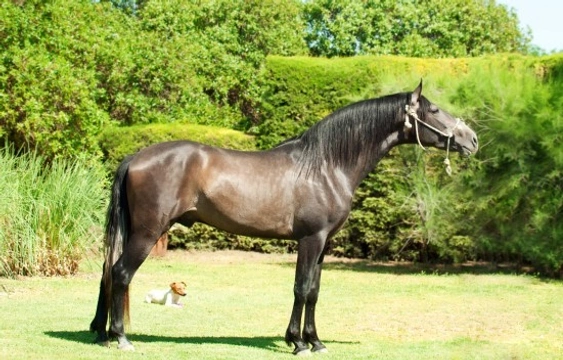
The Andalusian horse
Considered the Royal horse of Europe since the 16th Century, this breed are considered the perfect Classical Dressage horse. Developed in Spain as the perfect working horse, their intelligence was soon noticed by European studs. Andalusians were exchanged as gifts across the continent, more valued that Gold for their ability.
What do they look like?
Andalusians are a relatively small, compact horse which grows to around 15 hands. Developed for strength and balance, they have a broad flat back and muscular hind quarters and shoulder. The Andalusian has a wide chest, with plenty of room for the heart and lungs in their well-sprung ribcage. Their necks are muscular and arched, the perfect breed for classical riding and dressage. Their profile is straight or slightly convex, and those that differ are penalized in breed shows to keep the breed traditional.
They have an abundance of mane and tail, which is long and lustrous. It is kept natural and is plaited in elaborate ways to accentuate the neck and keep it maintained. Those in traditional competitions will be braided with ribbons, and their tails plaited up. Their coats are fine and silky.
The majority of Andalusians are grey or bay, but they also can be: black; buckskin; chestnut; cremello; dun; palomino; and, pearl. In the past they were also spotted and pinto, as seen in many Royal portraits. These colours were culled and no longer appear in the breed. The mustang horses of America still show these patterns.
The Andalusian really comes into its own through its paces. The Spanish registry insist that paces must be “brilliant, agile, energetic, cadenced and elastic, with appreciable elevation and extension, notable ease for collection and turns on the haunches.” A mouthful, but the Andalusian has delivered all such aims for centuries.
What is their temperament like?
Developed as war horses and to perform high school movements, they are incredibly intelligent and easy to train. Their intelligence means they need to be trained carefully, with the right rider they will learn quickly, and be responsive to the lightest of aids. Although docile, they are very sensitive. This is great for training as they react to slight weight changes and don’t require kicking; excessive aids can confuse them. Despite all of their power and exuberance, they don’t spook often and are quiet rides.
What events do they excel at?
With horses no longer being used in war, the Andalusian has proved its versatility by adapting to other sports and uses. With a strong engine and springy paces, they have been used in endurance and show jumping competitions. Their strength is in dressage. Many of the traditional Classical Riding trainers use the Andalusian to continue classical dressage. The Royal Andalusian School of Equestrian Art continue the baroque tradition, using Andalusians in “airs above the ground” performances similar to the Spanish Riding School of Vienna. Despite being relatively unpopular in previous decades, they are also now used in competitive dressage competitions especially by the Spanish Olympic team.
As part of their history, they excel at the Spanish walk. This is a walk where the front legs kick higher than the back. This is displayed in Spanish festivals and breed shows, with teams of Andalusians also pulling elaborate carriages in traditional Spanish tack.
With their ability to learn tricks and remain docile with novice riders, they are frequently used in films. With a noble appearance they are still the mount of Royalty, appearing in the Lord of the Rings trilogy, Gladiator, Braveheart and King Arthur.
If you want to see the horse performing its original purpose as a cattle horse, you can holiday on a number of ranches across Spain. They still work in the Spanish bull rings, using their intelligence and ability to deceive a bull, and get the rider close enough to remove a ribbon from their horns. This is still a brutal sport, and horses can get injured.
How have they influenced other breeds?
With the dominance of the Spanish conquistadors and armies between the 14th and 17th centuries, the Andalusian was taken across Europe and America. As a result they were bred to many of the local mares, starting to influence new breeds from an early time. Influential Royal families created State Studs to improve local breeds so they would make ideal war, farm and sports horses. With the Andalusian prized as the pinnacle of excellence, they were used to create: the Lippizaner; Kladruper; Gelderland; Hanoverian; Oldenburg; Holstein; Knabstrupper; Groningen; and, Friesian.
After the Spanish had looted the Americas, many bloodstock from Andalusia (the ancestors of the breed) were left to roam across the plains. These became the Mustang and Colonial Spanish Horse. More recently they have been exported to help create the Azteca in South America, and the Spanish-Norman in the 1990s. With their extensive history and proven ability to improve bloodstock they are the building blocks of the modern horse.
What should I look for when buying an Andalusian?
All horses must be registered with the Spanish Studbook to be considered a pure bred. These horses are known as Pura Raza Espanola (PRE) – you will see them advertised as PRE. The term Andalusian is actually used in Spain for unregistered or part-breds, so if importing make sure you are aware of what you are buying.
To become a registered PRE the horse must have a passport, microchip and be DNA tested to prove their parentage. Those already registered will have a birth certificate from the PRE to prove they are from pure Spanish lines. You will need all of this paperwork from the previous owner, especially if you plan to breed.
You must also do the same checks you would do when buying any horse. Make sure they are healthy, and get a vet inspection before committing to buy. Meet and ride the horse to make sure they are compatible with you.



